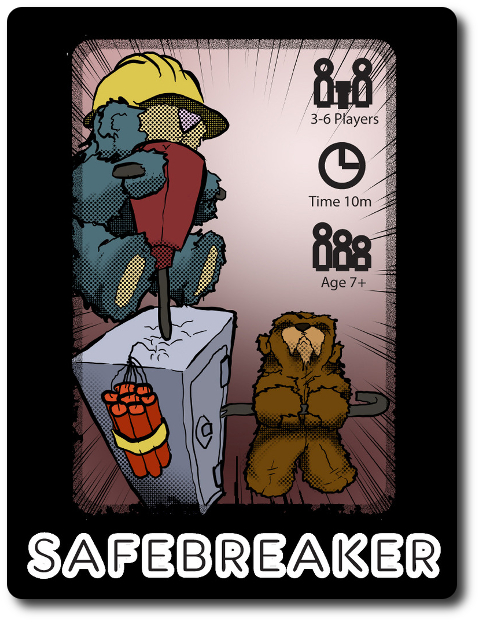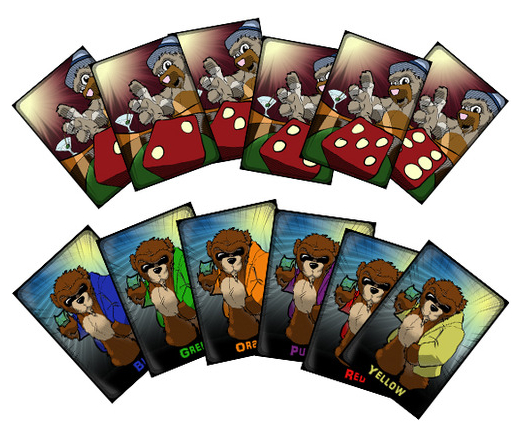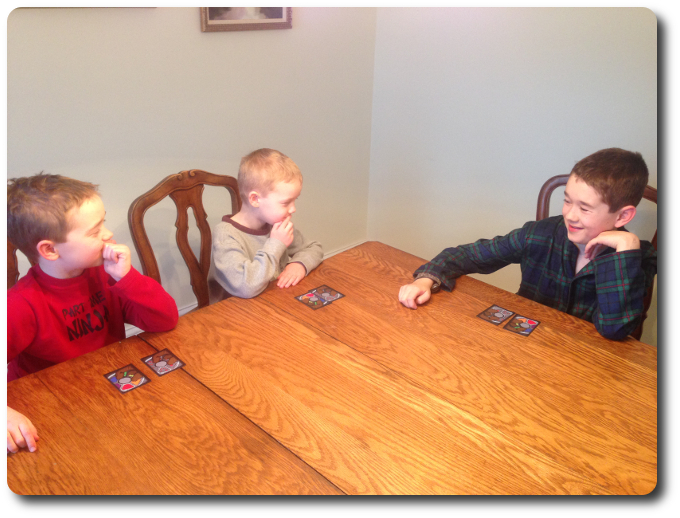
The Basics:
- For ages 5 and up (publisher suggests 8+)
- For 3 to 6 players
- Approximately 10 minutes to complete
Geek Skills:
- Active Listening & Communication
- Counting & Math
- Logical & Critical Decision Making
- Memorization
Learning Curve:
- Child – Easy
- Adult – Easy
Theme & Narrative:
- Solve the mystery combination before your opponents do
Endorsements:
- Gamer Geek approved!
- Parent Geek approved!
- Child Geek approved!
Overview
It was the perfect plan. Each of you learned one part of the combination to the safe so as not to arouse suspicion. Your plan worked and between all the members in your gang of thieves, you have the means to open the safe. But there’s a problem. None of you want to share what’s inside. If you were to learn what your partners know, you could open the safe yourself and keep it all!
Safebreaker, designed by Dave Cousins and published by North and South Games, is comprised of 6 Number cards and 6 Color cards. All of the cards are durable and are as thick as your standard playing card. The illustrations by Matt Maddock do a good job of portraying the colors and numbers, adding a bit of character to each card instead of just showing said number or color. On a funny side note, a few of our players thought the bears illustrated on the cards were Teddy Ruxpin.

Image courtesy of North and South Games
Game Set Up
To set up the game first separate the cards into their 2 types: Number and Color cards. There should be 6 in each pile.
Second, shuffle both piles separately and deal 1 Color and 1 Number card to each player, face-down. Players should look at their cards but keep them hidden from their opponents until they need to be revealed.
Third, set any remaining cards not dealt to one side of the game playing area, keeping them face-down. These cards are out for the duration of the game.
That’s it for game set up. Determine who will go first and begin.
No Honor Among Thieves
Safebreaker is played in turns with no set number of turns per game. On a player’s turn, they will ask one simple question to the opponent on their immediate left (in turn order sequence) or they can attempt to eliminate the opponent. Not both. If the question is asked, it’s phrased as follows:
“Are you [INSERT COLOR HERE] [INSERT NUMBER HERE]?”
For example, a player can ask, “Are you Red 4?” Or they could ask, “Are you Orange Five?”
The opponent MUST say “Yes” if they have either the Color or Number card that was named. But they do not have to show it, even if both the Color and Number card matched the question. For example, if the player asked the opponent if they were “The Red Four”, and the opponent had the “4” Number card, they would say “Yes”, even though their Color card was “Green”. The opponent should never make mention or suggest what cards they have. They only need to answer “Yes” or “No” to the question, but they cannot (and this is important) lie.
If the player wants to eliminate their opponent, they must correctly accuse their opponent by stating their Color and Number card. The game rules suggest the player make a hand gesture that looks like a gun to emphasis how serous they are. Like the question, accusing an opponent must be properly phrases.
“You are [INSERT COLOR HERE] [INSERT NUMBER HERE]!”
Note that it’s no longer a question, but a statement of fact. If the statement is correct, the opponent turns over their Color and Number cards, revealing them to everyone at the table. The opponent is now out for the duration of the game.
However, if the player accused incorrectly, the opponent responds with something sarcastic and the player must reveal their Color and Number cards to everyone at the table. The player is now out for the duration of the game.
The point is, if you accuse, you best know for certain or be really confident. When a player elects to accuse, 1 player will be out of the game.
The player’s turn is now over. The next player in turn order sequence who is still in the game now goes by either asking a question or accusing the opponent to their left.
The Game Within the Game
Safebreaker is all about listening, memorizing, and deducing. The player’s turn is actually the least important aspect of the game. As the player’s opponents ask questions, the player learns what their opponents think, memorizes the answers to the questions, and slowly begins to piece the puzzle together.
This is the game within the game. Asking questions is necessary to obtain knowledge, but it’s what the player does with the knowledge that is really important. If a player doesn’t pay attention to the entire table, they will only ever know the answer to their own questions, which really isn’t going to help.
As the game unfolds, Color and Number cards will be revealed. Revealed cards free up a player’s mind to memorize more information to ponder. In this way, the first third of the game is like stumbling in the dark, the second third is like walking in the dark with a flashlight, and the last third is a sprint to the finish line.
So pay attention and don’t be left behind.
Winning the Game
The game ends when only 1 player remains. This one player now knows all the Color and Number cards, meaning they can open the safe. It’s fun to do a big reveal with the final 2 cards, so make it something of a production. Expect opponents who are slightly bitter about losing to shout things like, “I KNEW IT!”
Game Variants
Safebreaker is easy to play, but that doesn’t mean it’s an easy game. A number of game variants are provided to help players tailor their game play experience to meet their needs. Each are summarized here.
Keep It Quick
If playing with less than 6 players, the cards not dealt are out for the duration of the game. This means players will not only have to figure out what cards are in play, but also what cards are out of play. This makes games longer. For a shorter game with less than 6 players, place the cards that are not in play off to one side of the game playing area, but place them face-up so everyone can see them. Now players know which cards are not in play and which cards to hunt for.
Keep It Simple
In the base game, an opponent does not need to reveal their cards if their Color and Number card are called. In this game variant, the opponent reveals the card that matches the player’s question, leaving any cards that do not face-down. Once the Color and Number cards are both face-up, the player is out of the game. This game variant removes the need to accuse players and works very well with younger Child Geeks.
Keeping Score
Playing smart should be rewarded. When a player correctly accuses an opponent, the opponent’s cards are placed in front of the player, face-up. At the end of the game, all players count the face-up cards they took from opponents, earning 1 point per card. The last player in the game earns a +1 point for every player in the game. The player with the most points wins. Note that you can only collect the cards that belong to the opponent, not the cards the opponent collected from other opponents. Those trophies belong to them.
To learn more about Safebreaker, visit the game’s web page.
Final Word
The Child Geeks understood what was expected of them right away. After playing the first game for longer than it really should take, I decided to change it up and include the Keep It Simple game variant. This removed the need to accuse, allowed younger players to guess without the fear of failure, and made the game faster. This turned out to be exactly what the younger Child Geeks needed. According to one younger Child Geek, “I was getting upset because I couldn’t remember what everyone was saying.” Yes, players are required to remember a lot and keep it all together. That can be stressful for younger Child Geeks who are not yet skilled enough to keep track of the game at the table and the metagame between the players. Another Child Geek said, “I like the version where you get to accuse and the one where you keep score the best. If I had to choose one, I’d say play with the score keeping.” The score keeping was a pleasant way to play the game. It gave the players an even bigger incentive to guess correctly and guess often. When all the games were over, the Child Geeks voted to approve Safebreaker, finding it to be very challenging, but also a lot of fun.

Time for my 5-year-old to ask an important question…
The Parent Geeks were having the same amount of fun as the Child Geeks. Safebreaker is a game that Child Geeks and Parent Geeks can play at the table together and without one group having a strong advantage over the other. This really appealed to the Parent Geeks. According to one such Parent Geek, “What I like about this game is that it’s all about paying attention and thinking things through. Those are skills that you get better at, but even my kids can play and beat this game with adults as opponents.” Indeed they can and did. Another Parent Geek said, “This game looks so simple, but golly, not a simple game. I really like how the game drags you in and every player’s answer is really meaningful.” After several games, the votes were collected. The final result was obvious if you observed how much fun everyone was having at the gaming table. Safebreaker was approved by the Parent Geeks.
The Gamer Geeks liked Safebreaker for two important reasons. I’ll just let one Gamer Geek sum it up, “This is a great example of a microgame. It’s small, but plays big.” Another Gamer Geek said, “This little game takes a much bigger part of my brain than I thought it would. Excellent fun and challenging.” And yet another Gamer Geek said, “There isn’t much to this game and I had some serious doubts about it when you said we were going to be playing as Teddy Bears, but I’m delightfully surprised. This is a serious game for serious people. I really enjoyed it.” In fact, none of our Gamer Geeks disliked the game. They all found it fun, challenging, and engaging. When it came time to vote, they all agreed to approve it, stating that Safebreaker was well designed, thoroughly enjoyable, and always challenging.
Make no mistake here, Safebreaker is a little game. It’s all about memory, thinking, and listening. You won’t be moving pieces across the game board, rolling dice, knocking down doors, or trading goods for gold. This is not that kind of game. Players will be asked to do 1 thing only and that is “figure it out, fast”. Clues are given IMMEDIATELY and there is no time to discuss clues with other players. Mostly because the game moves along at a quick pace, but more importantly, no one would willing share information with you. Each opponent at the table wants to see you go down, because when you do, you are no longer a threat and any information you are hiding becomes known.
Sounds rather cutthroat, doesn’t it? And that is exactly what Safebreaker is. It’s a cutthroat deduction game, where knowing more than your opponent will help you, but won’t save you. You best hope that the player who thinks they have figured out what your card combination is doesn’t have the moxie or time to accuse you. At least, not until you have a chance to accuse them. As the game continues and more information is given, every player starts to get ready to pounce. It’s like being at a gaming table with a bunch of hungry tigers who see you as a giant talking steak.
All this from a little microgame with 12 cards. It really is pretty neat, but alarmingly stupid, too. And I don’t mean the game is stupid. I mean the game’s concept is stupidly simple. So simple that you can explain the game in 1 minute or less. How to play is exceedingly intuitive and the goal is obvious. But don’t be fooled. This game is anything but easy. Every time I’ve played, it’s like I’m playing for the first time. I’m scrambling to keep all the information in my head, terrified that I just gave information away to an opponent who will use it against me, and I know full well that it’s only a matter of time before someone figures out the cards I’m hiding.
Man, I loved it. The thrill of the hunt and the fear of being chased all at once. This is a delightful little game, proving once again that you don’t need a game with lots of pieces, big boards, or fancy dice to have fun. All you need is a group of players who want to see you go down. Do try Safebreaker when the opportunity presents itself. Good stuff.
This game was given to Father Geek as a review copy. Father Geek was not paid, bribed, wined, dined, or threatened in vain hopes of influencing this review. Such is the statuesque and legendary integrity of Father Geek.



